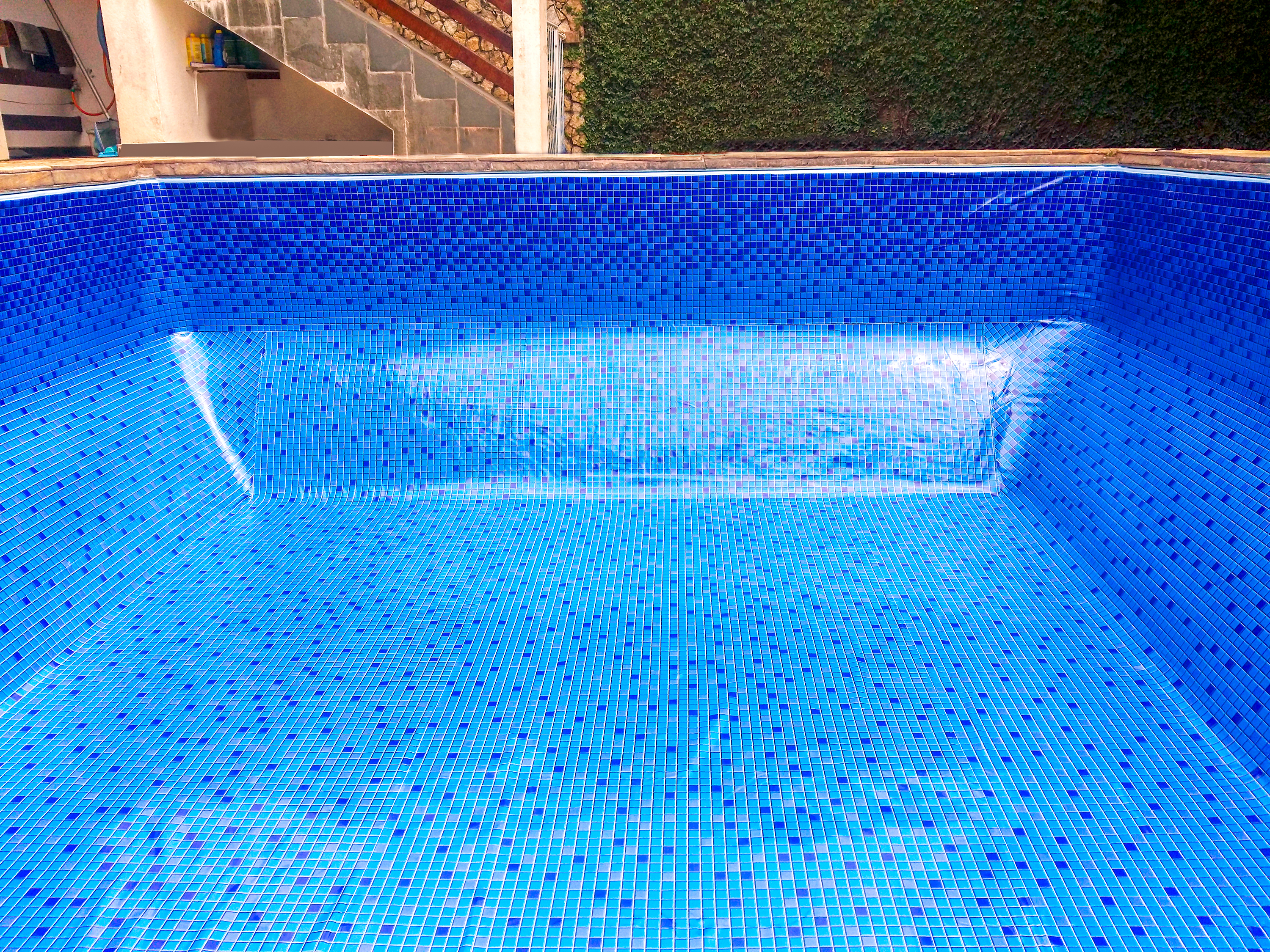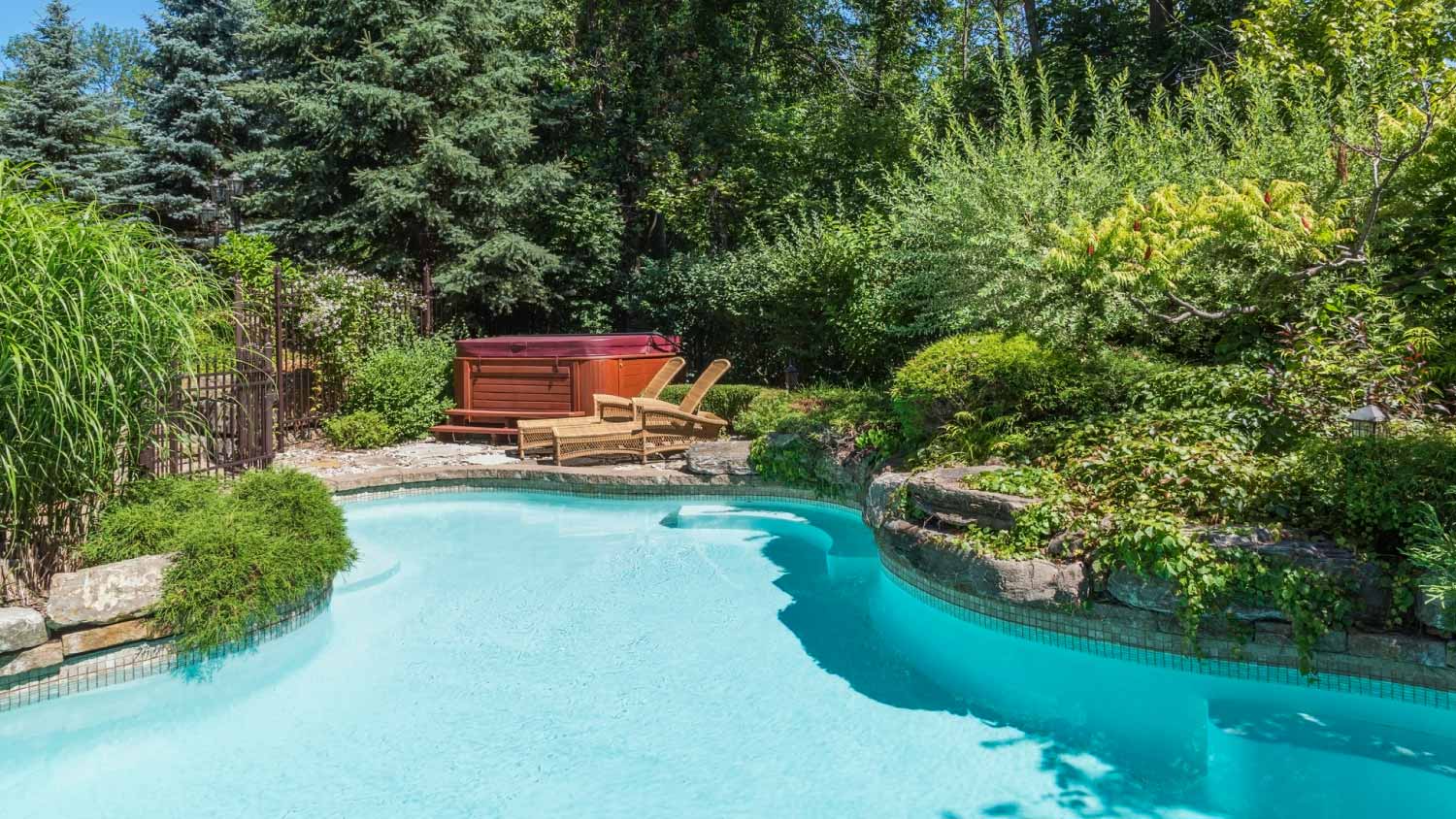
Find out the average cost to install a pool filter, including installation, maintenance, and replacement, plus tips on choosing the right filter for your pool.
Turn your pool from green to glorious with the right chlorine levels


Pool chlorine comes as a tablet, powder, or liquid.
Aim for a chlorine level of around 1 to 3 parts per million (ppm).
The average 15,000-gallon pool needs three to four 3-inch chlorine tablets per week.
Alternatively, you can use 5 to 9 ounces of powdered chlorine per week.
Liquid chlorine raises levels the fastest, and the average pool needs 1.5 gallons per week.
Your grass should be green—not your pool. This points to a problem with chlorine levels, but even if your pool doesn’t have a major issue, struggling to balance the chemicals is practically a right of passage. It takes a little learning and practice. This guide will teach you how much chlorine to add to a pool, what type, and whether or not you should hire a pro for swimming pool maintenance.
Pool chlorine, which actually contains several different chemical compounds, is a powerhouse of sanitization. According to the Centers for Disease Control and Prevention (CDC), it can kill most bacteria (think E. coli) in less than a minute, but some germs are more resistant and require consistent exposure. For this reason, pool safety isn’t just about how much chlorine you use, but how well you can consistently maintain proper levels.
You’ll need to test your water at least once a week during swim season. To stay on track, follow a weekly pool maintenance checklist.

Unless you have a natural swimming pool, you’re going to need to add chlorine. Swimming pool chlorine comes in three different forms. The one you pick will impact how much you need to add:
Chlorine tablets: Chlorine tablets, also known as chlorine pucks, are the most popular option because they cut down on pool maintenance. You can put them in a pool float and let them dissolve. They come in 1- or 3-inch tablets.
Chlorine liquid: Liquid chlorine is the best way to quickly raise the chlorine levels in your pool. However, since chlorine can break down in sunlight, you may need to supplement with a chlorine stabilizer.
Powdered chlorine: Powdered chlorine, or chlorine granules, are applied to the surface of your pool water by hand. This option gives you control over the dose, but unlike liquid chlorine, you can purchase stabilized versions that don’t break down in the sun.
Though chlorine is highly effective, some homeowners do opt for chlorine alternatives. Bromine is common in hot tubs and indoor pools because it’s stable at higher temperatures. It’s also good for those with sensitive skin because it causes less irritation. Saltwater pools, on the other hand, make chlorine using a salt cell. You won’t need to add traditional chlorine, but you will need to add salt.
The ideal chlorine level for a pool is 1 to 3 parts ppm. You’ll need to test your pool’s chlorine levels and read the chlorine’s packaging to know how much to add. For the average 15,000-gallon swimming pool, you’ll need to add three to four tablets, 5 to 9 ounces of powder, or 1.5 gallons of liquid per week.
Here are some general guidelines for how much chlorine to add to your pool:
| Size of Pool (Gallons) | Tablets (3-Inch) | Powder (Ounces) | Liquid (Gallons) |
|---|---|---|---|
| 5,000 | 1 | 2–3 | 0.5 |
| 10,000 | 2–3 | 3–6 | 1 |
| 15,000 | 3–4 | 5–9 | 1.5 |
| 20,000 | 4–5 | 7–12 | 2 |
Chlorine tablets: Add a single 3-inch tablet for every 5,000 gallons of pool water. If you have a smaller pool, choose 1-inch tablets to make sure you don’t over-chlorinate.
Powdered chlorine: Add 2–3 ounces of powdered chlorine for every 5,000 gallons.
Liquid chlorine: Add half a gallon of liquid chlorine for every 5,000 gallons.
Pool shock is a stronger form of chlorine. You’ll normally use it to open a pool, close a pool, or if your chlorine levels are seriously out of whack (like after a party, after a large storm, or if you notice your pool turning green). In short, shock is reserved for situations where you need to raise the chlorine level quickly, while regular pool chlorine is used for weekly maintenance.
Adding chlorine to your pool isn’t as simple as following a set schedule. There are some things that can impact chlorine levels and throw off the balance:
Sunlight: UV rays can degrade chlorine.
Cloudy weather: If your pool is more shaded than usual, you may lose less chlorine than you think.
Rain: Rain can dilute chlorine levels.
High temperatures: High temperatures can evaporate pool water and speed up bacterial growth, throwing chlorine levels out of whack.
Parties or extra swimmers: People introduce contaminants that the chlorine has to work harder to neutralize, so you lose chlorine faster when a large group is using the pool.
Debris: The more contaminants in the water, the more chlorine you’ll lose.
Improper maintenance: If you skip regular maintenance, you’ll need to add extra chlorine (or even shock your pool) later on
Choosing the right pool cleaning chemicals and maintaining the perfect balance takes careful effort. For this reason, many homeowners decide to hire a local pool service. If you do hire a pro, the cost of pool maintenance averages $30 to $260 per month.
From average costs to expert advice, get all the answers you need to get your job done.

Find out the average cost to install a pool filter, including installation, maintenance, and replacement, plus tips on choosing the right filter for your pool.

The cost of pool liner replacement in Columbus depends on the size and shape of your pool, as well as the liner material and type. Here’s how the costs break down.

If you’ve been considering installing a new pool in the Buckeye State, this guide will help you understand inground pool costs in Columbus.

How much shock does my pool need? Here's how to calculate how much pool shock to add to your pool based on its overall water condition.

A broken pool light can be dangerous as well as inconvenient. Learn who to call to fix your pool light safely and correctly.

The key to maintaining an aboveground pool is using the right tools and chemicals for the job. Use this guide to learn how to clean an aboveground pool.